ASUS U30Jc: Refining Thin and Light Performance
by Jarred Walton on May 18, 2010 11:23 PM ESTASUS U30Jc Gaming Performance
Thanks to the discrete GeForce 310M GPU, the U30Jc is also capable of handling most games at native resolution. In most cases, modern titles will need to run at low/minimum detail to achieve playability, but older titles and less demanding games will allow you to turn up some of the settings. We also added Battlefield: Bad Company 2 to our gaming results thanks to reader requests.
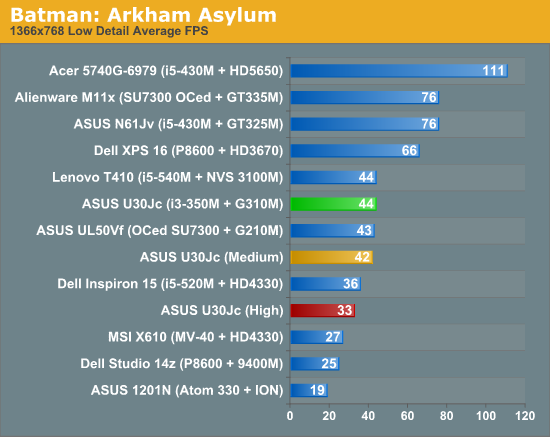
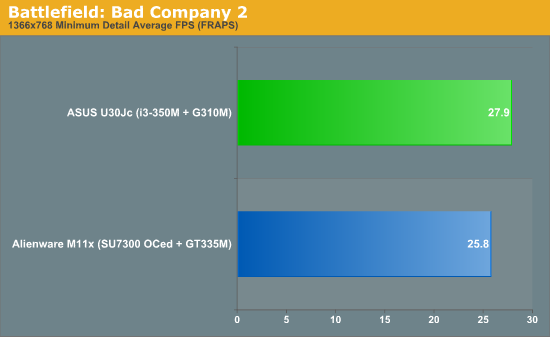

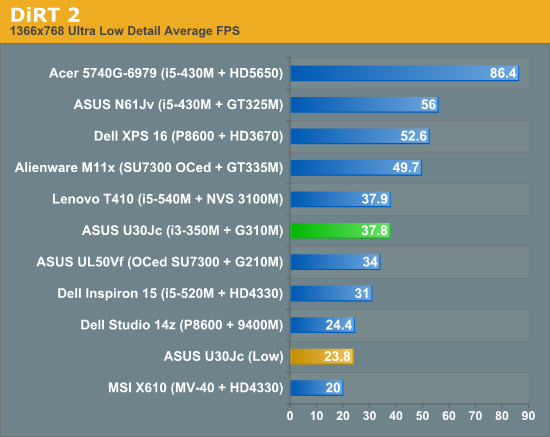
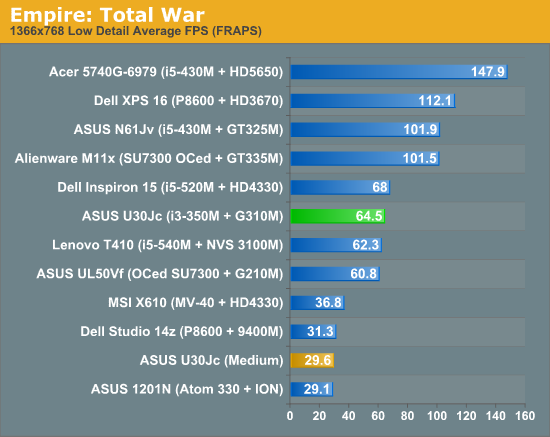
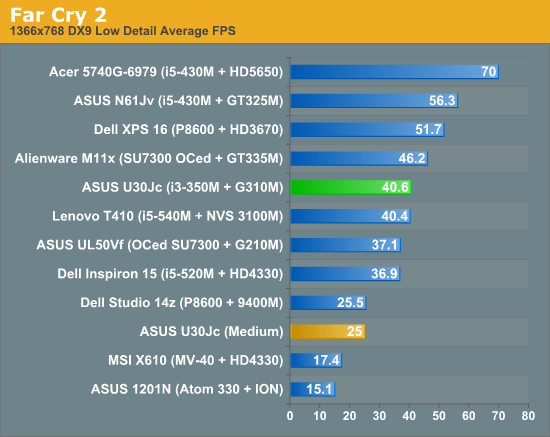
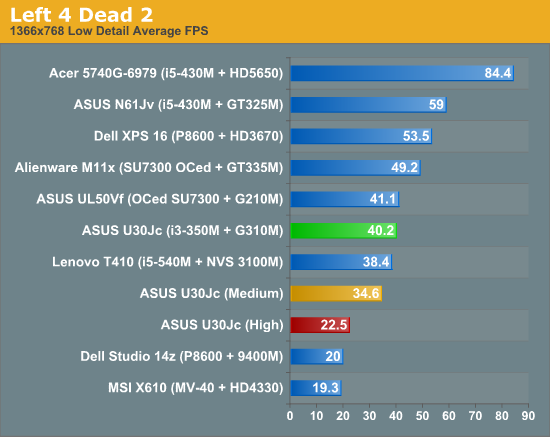
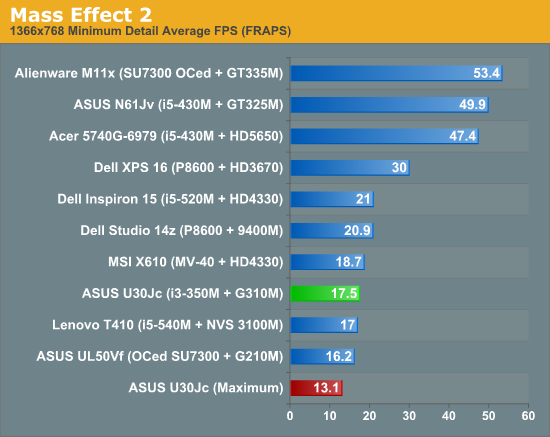
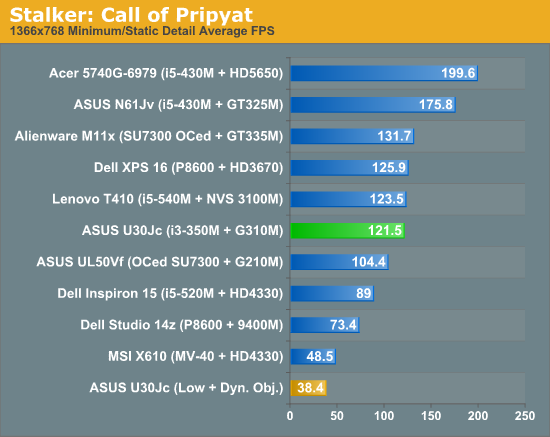
All of the games we tested were at least playable at 1366x768, with one exception. Mass Effect 2 really stresses the GPU subsystem on low-end GPUs, so it chugs along at sub-20 FPS in many areas. Likewise, we tried Dragon Age: Origins and found that it runs in the upper teens—a different engine than ME2, but apparently Bioware makes games that run similarly. Battlefield: Bad Company 2 is borderline playable, hovering just below 30FPS; what's interesting to note is that even with a much more powerful GPU, the M11x turns in lower frame rates in BFBC2. Battlefield games have always been rather demanding on the CPU side of the equation, and BC2 appears to continue that trend.
Of the remaining titles, Batman is able to run at Medium or High detail depending on your preference for smooth gameplay (you'll get short dips into the teens on High). Empire: Total War manages to deliver acceptable performance at Medium detail, and the current Optimus driver prevents us from choosing anything higher. (It appears that ETW looks at the capabilities of the Intel HD Graphics for determining available quality settings, even though it's definitely running on the 310M.) Left 4 Dead 2 runs fine at Medium but takes a pretty sharp drop moving up to High and there's definitely choppiness during the zombie mob sequences. Stalker looks like a 2005 game on minimum detail; bump things up one notch (low + dynamic object lighting) and you're looking at 2007 quality and equivalent performance. Anything more than that and you drop into the low 20s and teens.
As a gaming system, the U30Jc works okay but there will certainly be titles where performance is too low to run at 1366x768. Mass Effect 2 runs much better at 1024x600, but moving to a non-native resolution results in some fuzziness. If gaming is an important criterion for you, we'd recommend looking at other options. The Alienware M11x does quite well in games and should work for a while, provided you don't run into a driver issue down the road. Most other gaming capable laptops are going to be 14" or larger chassis, like the 14" Sony VAIO VPCCW22FX (i3 CPU with GT 330M) or the 15.6" Acer 5740G. ASUS also has a 14" ASUS N82J (i5-430M CPU with GT 335M) coming out that should still last 6+ hours on battery while combining a much more powerful GPU with Optimus Technology (something the Sony VAIO currently lacks).










57 Comments
View All Comments
solipsism - Wednesday, May 19, 2010 - link
I'd like to see this machine compared with latest MacBook. There seems to be some evidence to suggest Apple did the right thing withs sticking with C2D this time around in their 13" machines. This machine seems to be a great machine which to compare.Daeros - Wednesday, May 19, 2010 - link
I agree completely. For the extra hundred bucks, you get similar specs, even better battery life (and Bluetooth), as well as somewhat faster graphics. For all the bashing Apple takes for its pricing, it seems that whenever a pc company like ASUS or HP or Dell attempt to get to that level of size & performance, it winds up being very close in price.I second a request for this to go head-to head with the 13" Macbook.
anandtechrocks - Wednesday, May 19, 2010 - link
I disagree completely. if you go by apple's claims you get less than 50 minutes more battery life, a processor that is anywhere from 15-40% slower, half the ram, a smaller hard drive, and a plastic case for $100 dollars more. I know what I'd pick...FATCamaro - Wednesday, May 19, 2010 - link
Please note that the Asus doesn't appear to come with abgn networking instead just bgn. So it only has a 2.4Ghz radio it seems, not a 5 Ghz. one. I could be wrong. Other than that and the shit LCD it is a fine MBP alternative for Windows users.anandtechrocks - Wednesday, May 19, 2010 - link
mbp is like $300 more than this isn't it? I think the regular MB is a better competitor, which also doesn't have the best LCD. don't forget apple offers half the warranty of this Asus tooJarredWalton - Wednesday, May 19, 2010 - link
Depending on the application, you'd need about a Core 2 P9700 (2.8GHz) to equal a 2.26GHz Core i3-350M. In highly threaded workloads, the only way you'd com anywhere near the faster Core i5 processors is by getting a Core 2 Quad, but with the lower clock speeds on quad-core you'll be slower in lightly threaded tasks (i.e. the i3-350M is as fast as Q9000 in PCMark Vantage). It all depends on the app, but when you consider Core 2 Quad also consumes quite a bit more power in testing (i3/i5 idle far better than C2Q), there really aren't too many areas where I'd recommend Core 2 over Core i3/i5.I think Apple went with Core 2 Duo (P8600) for the MacBook because they could reuse some old tech and got a good price more than anything. (Maybe NVIDIA gave them a good deal on the chipset as well.) It also keeps the standard MacBook a decent step down from the MacBook Pro.
The Macbook has a 320M IGP GPU, so it has 3x as many shaders as 310M but it has to share system memory. (48 shaders at 950 vs. 16 shaders at 1530 means the 320M has 85% more shader performance but has to make do with about half the memory bandwidth.) That might mean it ends up with the same relative performance as the 310M in a lot of situations, depending on whether the particular game is bandwidth or shader limited.
Other than slightly better battery life I'd say the U30Jc beats the MacBook in most other area. The size and weight are pretty much the same (MB is slightly thinner but not enough that I'd worry about it), ASUS gives you 4GB vs. 2GB, and a 320GB vs. 250GB hard drive. It's $100 cheaper and has aluminum surfaces as well. I'm curious about the LCD, though... MBPs have good LCDs, but the standard MacBooks have usually skimped there. 1280x800 vs. 1366x768 is a wash in my book but I'm sure some would prefer the 16:10 AR of the MacBook.
Of course, if you prefer OS X over Windows 7 the choice is clear. Similarly, if you prefer Windows 7 there's no point in buying a MacBook. MacBooks booting Windows have never reached the same battery life as under OS X. Anyway, we'll see if we can get a MacBook for testing, but I won't be the one doing the review.
VivekGowri - Wednesday, May 19, 2010 - link
The 13" MacBook Pro also has a Core 2 Duo, suggesting more that Apple didn't want to put Core i5 processors into the smaller/cheaper models. Whether this is because they wanted to differentiate the larger/more expensive 15" model, or because they wanted to maximize profit margins (C2D's must be dirt cheap right now...) we don't know.It just doesn't seem entirely likely to me that they couldn't do it or couldn't fit both the larger i5 processor package and the secondary IGP into the MB/MBP case (there are enough other laptops with Core iX and dedicated graphics out there in small chassis; the U30Jc is just one example). Also, I'm not buying Steve's comment that Apple couldn't justify the "very small CPU speed increase".
I may (*may*) end up with one of the newly updated MacBooks sometime soon, but as Jarred says, we'll see if we can get one and who does the review.
Penti - Wednesday, May 19, 2010 - link
Hardly, a Core i5-520M costs $225 and a P8600 costs $209 (listed price), there no price difference in the processor/chipset platform. It's $265 with chipset for 520M + HM55. Apple might get an rebate, but they might get one or the newer platform too. It's probably the same cost as the old hardware any way. Overpriced as usual.Penti - Wednesday, May 19, 2010 - link
I think more then likely it's just space concerns that has them using C2D + NVIDIA chipset, they do the same in the MBP 13" for the same reason. Switching to Core i5 + HM55 + GPU / Memory takes up more space on the circuit board. Something there aren't a lot of on Macbooks. Of course this is essentially the old Macbook so they could reuse pretty much everything anyway. The chipset is probably even pin-compatible. But they appear to have tweaked the battery though, although the case itself is exactly the same.Of course something like adding to the size of the PCB would dictate a case redesign and the removal of the dvd-drive possibly.
JarredWalton - Thursday, May 20, 2010 - link
As I pointed out in the MacBook posting comments, there's no problem with getting all of the components with a discrete GPU into the MacBook. It's .1" narrower and .4" less deep, but ASUS has a removable battery that accounts for much of the extra depth. Apple chose the old platform for cost savings--both for the lower prices on the CPU+chipset as well as the ability to reuse the old design without having to spend a lot of time on accommodating a new chipset, CPU, etc. The sad thing is that Apple doesn't pass any of those savings on to the customer: a MacBook still costs $1000, even if it has two year old technology--outside of the chipset, which you could argue is "new". Too bad we never got a chance to have that chipset back when it would have been useful; now it's relegated to Core 2 platforms that are going away.